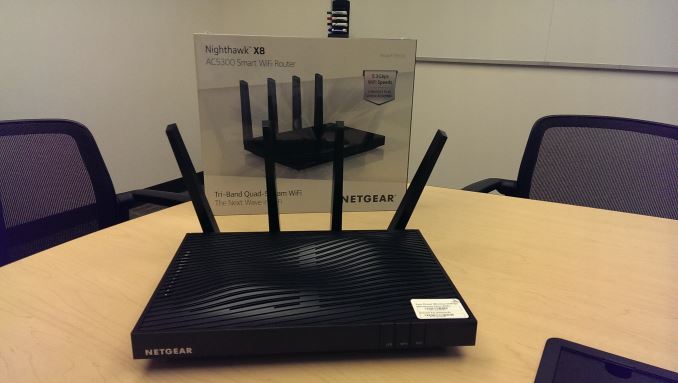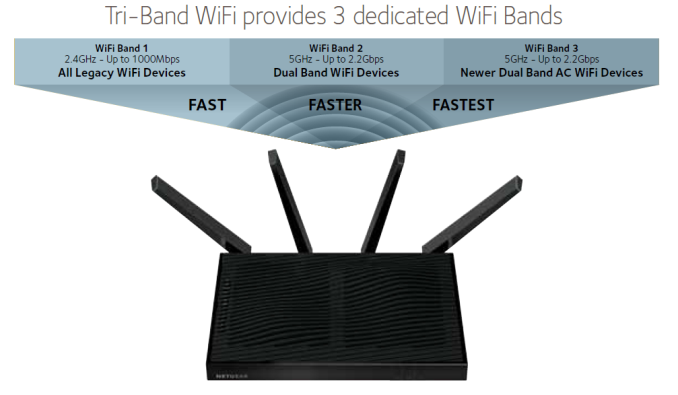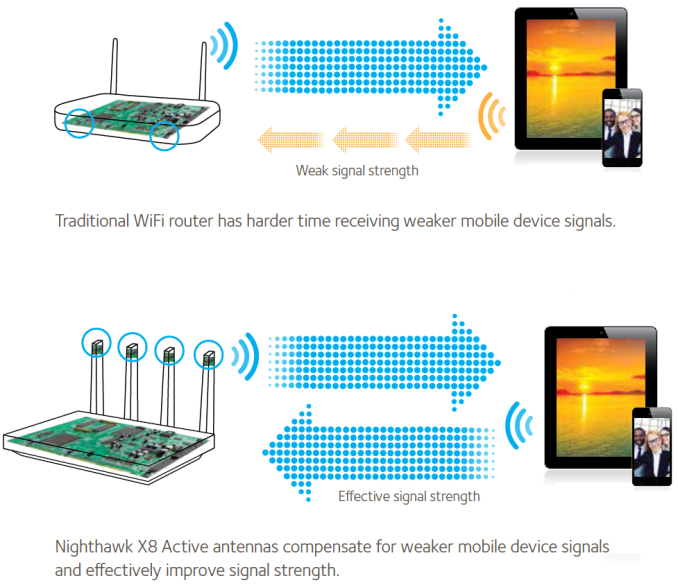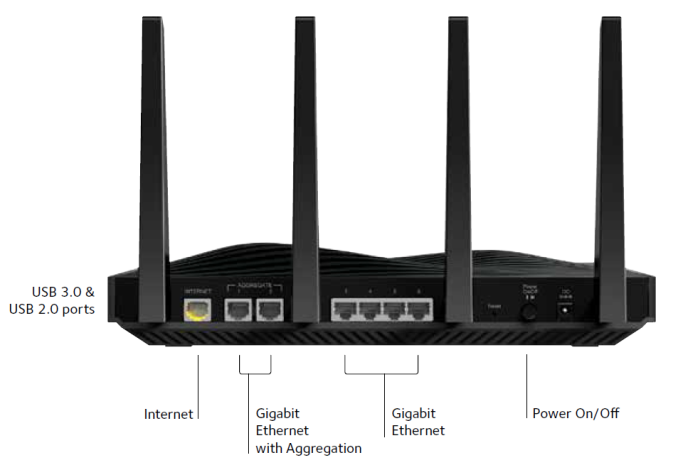Netgear Nighthawk X8 (R8500) Wave 2 802.11ac Router Set to Ship
by Ganesh T S on October 1, 2015 8:30 AM EST- Posted in
- Networking
- NetGear
- Broadcom
- 802.11ac
- Wi-Fi

Broadcom's XStream platform has enjoyed quite a bit of success in the Wi-Fi router market despite its high cost. The first generation XStream platform used a 3x3 configuration for each band, and lacked Wave 2 features such as MU-MIMO support or 160 MHz channels. At the 2015 CES, Broadcom updated their XStream product portfolio with the BCM4366, a 4x4 MU-MIMO capable radio that could work along with the BCM47094, a dual-core Cortex-A9-based network processor SoC. At the same time, D-Link also announced the DIR-895L AC5300 router based on that platform. Early last month, we also had Asus announcing the RT-AC5300U with the 4x4 tri-band XStream configuration. Unfortunately, none of these announcements came with a concrete ship date. Netgear was conspicuously silent about their plans with the new platform, even though they were the first vendor to come out with a product based on XStream Gen 1 - the Nighthawk X6 (R8000). Today, Netgear is announcing the Nighthawk X8 (R8500) based on the second generation XStream platform. Unlike the announcements from other vendors, the R8500 is available for purchase today.
As a recap, the tri-band Wave 2 XStream platform integrates two 4x4 5 GHz radios (at 2.1 Gbps each) and one 4x4 2.4 GHz radio (at 1 Gbps). The setup is capable of using 1024 QAM (Broadcom-proprietary NitroQAM, works only with clients having Broadcom Wi-Fi receiver chipsets) to boost performance. Most of the
Wi-Fi aspects have been covered in our D-Link and Asus router launch articles, and I won't go into detail here. Instead, the focus of this piece will be on the differentiating aspects in the Nighthawk X8.
The most striking aspect of the R8500 when compared to the other XStream Gen 2 routers is the presence of only four external antennae instead of eight. Netgear has opted to go for four external and four internal ones. Physical appearances aside, the four external antennae are all active ones. This is the first time that we are actually seeing active antennae being deployed - the Wi-Fi amplifiers are moved from their usual location in the router's motherboard to the top of the antennae. This reduces cross-talk on the board and also avoids signal loss in the transmission between the antennae and the board.
The other interesting feature is the availability of 6 LAN ports in addition to the WAN port (all GbE, obviously). Two of the 6 LAN ports come with 802.3addynamic link aggregation support in-built into the firmware. For select devices (such as certain ReadyNAS models), connecting both wired ports to ports on the device will automatically configure everything to take advantage of the teamed link. For example, it will be possible for two different wired clients or multiple Wi-Fi clients to stream out simultaneously from the NAS and get more than 1 Gbps of effective throughput from the NAS.
Note the industrial design with two waves on the top of the chassis - indicative of a Wave 2 device
Like all other XStream Gen 2 products and Quantenna-based products, the MU-MIMO capability is present in the hardware, but the firmware to enable them will be made available later on. Netgear indicated it would be before the end of the year, but we wouldn't be surprised if it comes only after the Wi-Fi Alliance starts certifying MU-MIMO interoperability in 2016.
Other than the active antennae and link aggregation features, the R8500 comes with the standard value-adds that have been part of all the Nighthawk routers since the R7000 - beamforming, dynamic QoS (based on Broadcom's iQoS engine in the Broadcom-based routers and the Qualcomm Atheros StreamBoost engine in the Quantenna-based routers), VPN and DLNA support. All the XStream Gen 1 features in the R8000 (such as 'Smart Connect' to steer clients to the appropriate band) are carried over to the R8500. The router also comes with ReadyCLOUD USB Access, which enables secure access to any USB drive connected to the router over the Internet. Netgear also supplies ReadySHARE Vault, a PC program for backing up content to any USB drive attached to the router. Consumers loath to accessing a web UI to monitor / configure / repair their networks can also use the Netgear Genie app for this purpose.
The Nighthawk X8 R8500 AC5300 router is available for purchase today at an MSRP of $400.
Source: Netgear













29 Comments
View All Comments
Makaveli - Thursday, October 1, 2015 - link
Another Nighthawk user R7000 running Asus Merlin firmware router is solid.$175 also much better hit on my wallet. If I'm going to start paying $400+ I might as-well just start looking at Enterprise grade equipment.
iwod - Friday, October 2, 2015 - link
What does it mean by Tri Band, There is only 2.4Ghz and 5Ghz. What is the third band?What they say 4x4 for 2.4Ghz and 4x4 for 5Ghz Antenna, does it mean they have 16 Antenna? ( Since the 4x4 is suppose to be 4 pairs, hence 8, and two set is 16 )
Then the maximum bandwidth from the router is limited by 8 antenna serving maximum possible of 1Gbps + 2.2Gbps.
Assuming they are using the 5Ghz 2nd 80Mhz as Band 3, you still could not achieve the maximum rate of 5.3 because the 5Ghz antenna is shared.
Am i missing something?
DanNeely - Friday, October 2, 2015 - link
As explained in the graphic, it can run two 5ghz connections at a time without MU-MIMO in addition to the 2.4 GHz connection.As for the rest of your questions, dunno how the antenna multiplexing works.
zodiacfml - Friday, October 2, 2015 - link
The third band is another 5Ghz signal, on another frequency range, similar to having two 5ghz Wi-fi routers.The antenna count is 8. 4 external and 4 internal (for 2.4 ghz)
The 4x4 means that it is a 4 stream signal. The next "4" means it is capable of MU-MIMO to 4 clients/devices. It can stream a 4 stream signal to 4 devices simultaneously (being MU-MIMO). Then, repeat that capability on the second 5 Ghz signal. Super overkill actually. I can't think of a actual scenario that can effectively use these abilities.
LarsBars - Friday, October 2, 2015 - link
That's pretty cool that it has two 802.3ad ports. Windows 10 supports LACP NIC teaming out of the box using with the New-NetLbfoTeam PowerShell cmdlet. It would be interesting to see if the teaming compatibility is plug and play with Windows 10.cromags77 - Tuesday, October 6, 2015 - link
still, the firmware is problematic. i've gotten to a point where i am not going to use a router, regardless of the tech capabilities, unless it is dd-wrt or tomato compatible. in this age of NSA, tech users need to be careful. if you know enough to be using this site, you should set yourself up a VPN server using a DD-WRT router. TOR has a slew of issues, and seems to be connected to gov't agences- there is a pretty solid PANDO article on this. VPN services, they're cool- but still, if the federal government shows up to their offices- you know they are giving up all the information they have about you. use a DD-WRT router, set up your own VPN server. if you fear bricking your router, buy a DD-WRT router from FlashRouters. if you can do it yourself, do it yourself. you may think you are free from the NSA, as you haven't committed any crimes- but if you have some disparate opinions, they'll put you on "the list", monitor you, and make a case against you. any kind of anti-globalist, anti-government opinion can get you monitored... be it occupy wall street, tea party, hardcore libertarianism... anything outside of "the mainstream". i know i seem crazy, but i've read 1984. this stuff is happening now.jfallen - Tuesday, October 6, 2015 - link
This is all well and good (awesome actually, genuine gigabit wireless seems a real possibility here.) But you know what would be really awesome, a mini-PCI-E or normal PCI-E 1x card that has 4 antenna so I can actually use the available bandwidth...Asus has a 3x3 PCI-E 1x solution (+ a 3x3 on-board solution on some of its skylake MB's,) but the mini-PCI-E space is stuck at 2x2 with intel's (admittedly very good, I get a stable 40-50MB/s sustained transfers,) AC-7260 series products.
GIVE ME A 4x4 CLIENT DEVICE. (or point me in that direction:)
glpdx - Wednesday, October 28, 2015 - link
My R7000 required the occasional reboot. They've must have sorted out the firmware because it's been rock solid for the past year. I've been looking for an excuse to upgrade but I'm not seeing anything (feature or performance) that I would even notice on a day to day basis. I really do wish they'd make a flagship access point (R8500 w/ just WIFI...no router or other junk)TorXXX - Friday, November 20, 2015 - link
Having the R7000 with Tomato FW, rock stable! But my NAS required a NetGear smart switch to implement link aggregation, would be useful to include this into the wireless router!Tomato FW is the perfect blend of speed and functionality, it even includes support for CTF which enables for up to 1 Gbit NAT speed. But then the IO graph calculations will not work correctly. No need for speed below 350 Mbit line.
NetGear has good HW, but FW is usually junk. Thank to Tomato and other 3rd party FW makers!